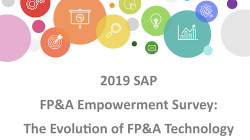As Einstein said, “In the middle of every difficulty lies opportunity.” This survey we believe offers hope, insight, and a much-needed reality check on where FP&A is today. It also forecasts what needs to happen for FP&A teams to develop their best practices from theory into reality.
In this uncertain, technology-driven world, we conducted a survey of global FP&A professionals to assess whether the work they do and the skill sets they employ are ‘good enough’.
Integrated FP&A is not a new term. Most experienced FP&A professionals are probably already subconsciously doing it. Integrated FP&A promotes the idea of collaborative planning where finance professionals work with different parts of the organisation to create a holistic view and plan.
There are many terms connected with FP&A, such as “unstructured analysis,” “predictive analytics,” and “machine learning". Often very little detail on how they can be used in everyday life. Sure, there is an odd example such as how the sales of one product in a supermarket are related to another based on their location. But what do these technologies actually do, and how can they help management in today’s fast-moving, complex business environment?
FP&A Predictive Analytics and Scenario Planning represent a truly powerful force for dealing with uncertainty, complexity, and risk. Watch the full recording of the UK&Ireland Board to learn more about the key factors that are needed for the successful implementation of Predictive Planning and Scenario Planning.
To be successful business partners, FP&A professionals should capitalise on the latest technological advances. So how can we digitise FP&A Business Partnering effectively?
Pagination
Subscribe to
FP&A Trends Digest

We will regularly update you on the latest trends and developments in FP&A. Take the opportunity to have articles written by finance thought leaders delivered directly to your inbox; watch compelling webinars; connect with like-minded professionals; and become a part of our global community.






